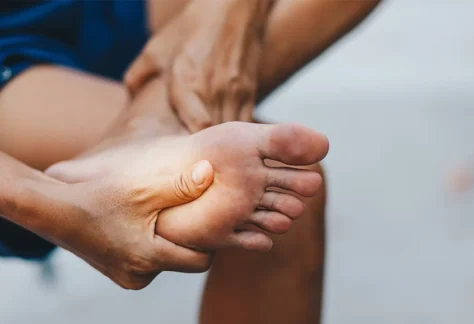In This Article:
- Chronic pain is any type of muscle or joint pain that lasts longer than 6 months. It can be treated through non-pharmacological pain management or alleviated through medicinal pain management.
- Arthritis is a condition that causes joint inflammation and chronic pain that can last a lifetime. The two main types of arthritis are osteoarthritis, caused by repetitive trauma, and rheumatoid arthritis, caused by the body’s immune system.
- Osteoarthritis can be treated through non-pharmacological pain management and rheumatoid arthritis can be treated and prevented with medications.
Over 100 million people in the United States suffer from some form of chronic pain. Within that figure, 54 million American adults have a sub-category of chronic pain called arthritis. To learn how to treat chronic pain and arthritis, you’ll need to understand the symptoms, their causes and who these conditions most commonly affect.
Chronic Pain Symptoms and Causes
Chronic pain is any type of muscle or joint pain that lasts longer than 6 months. The condition has a wide range of causes that can affect all parts of the body, sometimes making it difficult to identify, address and treat. Unlike acute pain, chronic pain persists well after your injury is healed.
Chronic pain can affect people of any age, gender, race or background. Causes of chronic pain can include headaches and migraines, neck, back and spinal pain, cancer, systemic diseases, fibromyalgia and the aftermath of a traumatic injury caused by a strenuous activity.
If you think you may have this condition, look for these common chronic pain symptoms:
- Sore joints or muscles
- Deep, achy pain
- Sharp shooting or burning pain
- Limited range of motion
- Fatigue and decreased energy
How To Treat Chronic Pain
The first step to treating chronic pain is talking to your doctor about your symptoms, so they can help you identify their source. Once identified, your doctor will work with you to find the best combination of treatments to help alleviate your pain. It’s important to explore all your options, but here are a few examples:
Non-pharmacological pain management includes physical therapy or occupational therapy to help you regain strength and mobility. Many also find relief through methods like massage and acupuncture. Meditation and behavioral management can also help target chronic pain from another angle.
Medicinal pain management alleviates chronic pain through medicines such as acetaminophen, nonsteroidals, antidepressants and even antiepileptics, which target nerve pain neurologically.
Chronic pain can be both physically and emotionally taxing, but the good news is there is no shortage of methods to ease your symptoms.
Arthritis Symptoms and Causes
Arthritis is a condition that causes joint inflammation and chronic pain that can last a lifetime. The origin of this disease depends on its type, with rheumatoid arthritis and osteoarthritis being the most common. Osteoarthritis is caused by either degenerative wear-and-tear or repetitive trauma. Rheumatoid arthritis is when your immune system attacks your body’s joint tissue.
There are a variety of factors that can increase your risk for arthritis. Although the condition affects children and adults alike, the risk increases as you age or gain weight — especially with osteoarthritis. Athletes are also vulnerable because of the repetitive trauma placed on their joints. Smoking, family history and abnormal joint tissue are common causes, as well.
Finally, if you crack your knuckles, don’t worry — contrary to popular belief, this does not lead to arthritis.
With arthritis, symptoms creep up on you over time. Look for:
- Joint pain (sharp or dull)
- Stiffness
- Swelling (especially with rheumatoid)
- Fatigue
- Aching for over 6 months
- Inhibited daily functions
How to Treat Arthritis
If you’re experiencing symptoms of arthritis, you should visit your doctor right away to get on top of the pain. Your physician will perform lab work and imaging to provide a diagnosis and form a treatment plan around your needs.
If you have osteoarthritis, you’ll have to rely on mostly non-pharmacological pain management, like exercising, stretching, attending physical therapy and applying topical ointments. However, Tylenol, N-SAIDS and joint injections have proven effective to an extent.
For rheumatoid arthritis, your doctor will prescribe medication to stop your immune system from attacking your joints. Unlike osteoarthritis, rheumatoid arthritis treatment can prevent progression of the disease. Doctors hope to find total cures for both types of arthritis in the near future.
If you feel any arthritis or chronic pain symptoms, speak with your doctor before it becomes severe. With many treatment methods available, you may be able to return to all your favorite activities in no time.
To learn more about how to treat chronic pain, find a nearby Valleywise Community Health Center or call 1 (833) VLLYWSE to schedule an in-person or virtual appointment.
Sources:
- https://www.healthline.com/health/chronic-pain
- https://www.cdc.gov/arthritis/index.htm
- https://www.nccih.nih.gov/research/research-results/defining-the-prevalence-of-chronic-pain-in-the-united-states
- https://www.cdc.gov/nchs/products/databriefs/db390.htm#:~:text=Summary-,Overall%2C%20the%20prevalence%20of%20chronic%20pain%20was%2020.4%25%2C%20and,65%20and%20over%20(30.8%25
- https://www.arthritis.org/health-wellness/detail?content=aboutarthritis
- https://my.clevelandclinic.org/health/diseases/12061-arthritis








